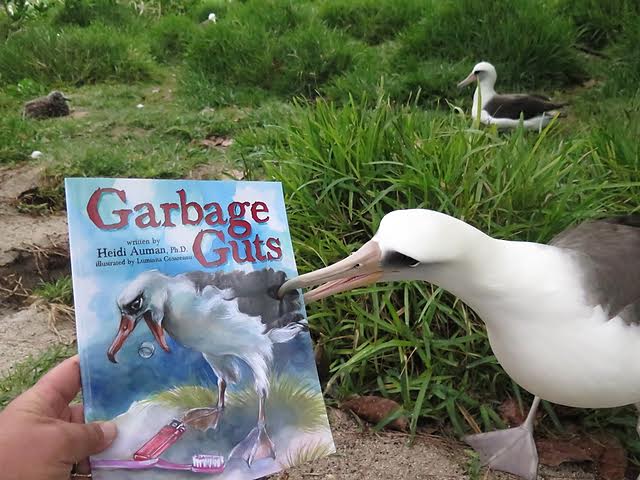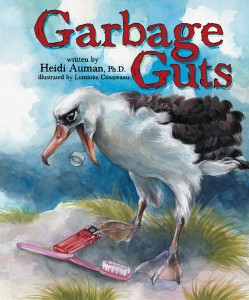UPDATED
"Attention all parents, teachers, librarians, environmental and educational groups - I've created a video narrating my children's book, Garbage Guts, to share for free. This was part of my isolation challenge and what I can do to make our world a bit nicer place. Please share with anyone who may be interested. At the end is a short lesson on my research behind the story, plus an educational handout on how to lower your 'plastic footprint'."
View author Heidi Auman reading her book (with realistic barfing noises) here.

Garbage Guts gets a critical review from a Laysan Albatross, photograph courtesy of Heidi Auman
**********************************************************************************************************************************************************************************************************
“Aria the Albatross was about to barf. “Haccck! Eccch-pwah!” With a cough and a splatter she threw up a pink plastic toothbrush, a red plastic cigarette lighter; and a white plastic bottle cap on the soft white sand.”

Garbage Guts by Heidi Auman
Heidi Auman, who lives in Tasmania, Australia, has in the past studied plastic and chemical pollution in albatrosses on the USA’s Midway Atoll. Armed with this hands-on experience – and a passion for sharing her scientific knowledge with a wider audience, including young people - she has now written a book for children on the subject. In her book, dramatically illustrated by Romanian artist, Luminita Cosareanu, Heidi has Ari, a female Laysan Albatross Phoebastria immutabilis, travel away from her island home to find out where all the plastic items she and her albatross friends have been regurgitating are coming from.
On her journey over a sea full of floating trash she meets other animals that have been affected; a turtle that has half swallowed a plastic bag, a seal caught up in a strapping band and a whale entangled by a ghost fishing net. Aril helps the turtle and seal to get free but has to call on some nearby humans to help free the whale.
The take-home message is that marine pollution is derived from the land and that children can help and become involved by joining beach clean-ups.
The text includes some short poems sang by each distressed animal as thanks to the concerned albatross. With page-sized illustrations to look at this book would be a good bed-time story for parents to read to their young sons and daughters, who could join in with learning and singing the songs. The text is large and should be easy for children learning to read to follow.
Click here and here for two other accounts of Heidi’s book.
Heidi Auman has worked with the Albatross and Petrel Agreement in the past, helping research and write several of the ACAP Species Assessment texts for albatrosses.
Click to view a listing of other children’s books on albatrosses and petrels on this website: it’s been visited nearly 4000 times!
With thanks to Heidi Auman.
Reference:
Auman, H. 2014. Garbage Guts. Illustrated by Luminita Cosareanu. Indianopolis: Dog Ear Publishing. Unpaginated [64 pp.].
John Cooper, ACAP Information Officer, 05 October 2014, updated 13 May 2020

 English
English  Français
Français  Español
Español